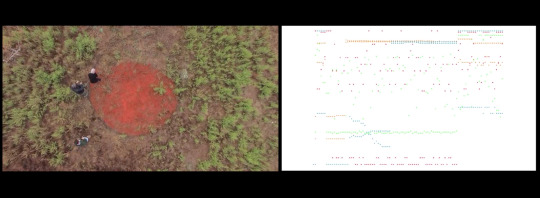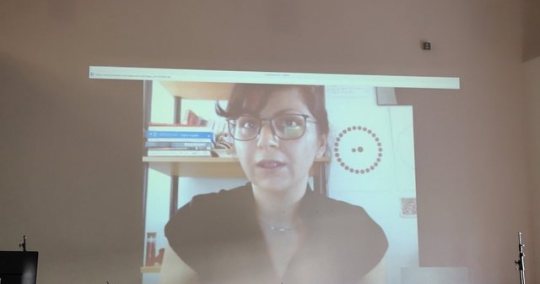#geointelligence
Text

Talk en ligne dans le cadre du séminaire: « Electronic bodies and the abstract morphology of the real », à Goldsmiths university of London, le 11 Juillet 2019, organisé par le festival Electropixel 9 et co-dirigé par Iris Garrelfs & Julien Ottavi.
Titre de mon intervention: « Impressions, pollen en fuite » et comment faire corps avec le monde.
Extrait:
"Ce diagramme via les points singuliers qui le composent écrit un peuplement progressif et une mutation programmée par un ensemble d’affects invisibles et par un noyau relationnel qui fait machine abstraite. C’est du big data certes, c’est aussi de l’écriture collective sans écriture d’un réel potentiellement présent et potentiellement ici et ailleurs. C’est un germe géo-pictural et géo intelligent en pleine transformation.
“Impressions, pollen en fuite”, le titre de cette intervention et un clin d’oeil au tableau de Paul Klee Angelus Novus qui représente une allégorie de l’ange de l'histoire selon Walter Benjamin dans son texte “sur le concept de l’histoire”, Il représente un ange qui semble en train de s’éloigner du lieu où il se tient immobile. Le tableau indique l’ange en fuite entre plusieurs indications temporelles, il représente une approche de la temporalité.
Dans ce contexte, notre pollen indicateur de mobilité, de fécondation, de semence et de « motifs » d’informations est en constante alternance de mouvements d’ancrage dans le réel et de fuite vers la multiplicité et la bifurcation des vies. Symbole du vivant Il contribue à sa propre archéologie et sédimentation pour devenir des formes de « vie » qui opèrent au-delà de l’organique et agencer une machine abstraite celle de la pensée géo relationnelle.
Le pollen en fuite c’est cet « être » qui devient, qui se transforme et se manifeste au singulier ou au pluriel. Il traverse les temps, les espaces et les relations et rend visibles et ubiquitaires les intensités dans un processus de dissémination.
Quels corps, quels temps et quelles relations pour les informations en fuite ?
Quels rapports a cette démarche de l’information à l’écologie à la politique et aux sciences ? Quelle écologie de l’information qui nous intéresse, celle de la communication ou celle de la création ? "
#apo33#electropixel9#goldsmithuniversityoflondon#géopicturalité#geointelligence#georelational#souadmani#artetrecherche#digitalhumanities#data#landscape#motty#iot#data visualization#datascientist#dataviz#wujud
0 notes
Photo

Talk en ligne dans le cadre du séminaire: « Electronic bodies and the abstract morphology of the real », à Goldsmiths university of London, le 11 Août 2019, organisé par le festival Electropixel 9 et co-dirigé par Iris Garrelfs & Julien Ottavi. Titre de mon intervention: « Impressions, pollen en fuite » et comment faire corps avec le monde. « Impressions, pollen on the run »and how to become one with the world. Extrait: « Dans ce contexte, notre pollen indicateur de mobilité, de fécondation, de semence et de « motifs » d’informations est en constante alternance de mouvements d’ancrage dans le réel et de fuite vers la multiplicité et la bifurcation des vies. Symbole du vivant Il contribue à sa propre archéologie et sédimentation pour devenir des formes de « vie » qui opèrent au-delà de l’organique et agencer une machine abstraite celle de la pensée géo relationnelle. Le pollen en fuite c’est cet « être » qui devient, qui se transforme et se manifeste au singulier ou au pluriel. Il traverse les temps, les espaces et les relations et rend visibles et ubiquitaires les intensités dans un processus de dissémination. » S.M Présenté en Anglais avec mon accent Français ;) #apo33 #electropixel9 #goldsmithuniversityoflondon #géopicturalité #geointelligence #georelational #souadmani #artetrecherche #digitalhumanities (à Goldsmiths, University of London) https://www.instagram.com/p/Bz2RGdohbUM/?igshid=zwocet0yoi69
#apo33#electropixel9#goldsmithuniversityoflondon#géopicturalité#geointelligence#georelational#souadmani#artetrecherche#digitalhumanities
0 notes
Text
Op-ed | The future of geointelligence is about information dominance, not data - SpaceNews
0 notes
Text
Airbus launching new satellite system
By Vincent J. Curtis
When you think of Airbus, most people think of it as an aircraft manufacture famous for its A300 and A200 series commercial aircraft, fighters like the Eurofighter and multipurpose military aircraft such as the C295 and MRTT. But Airbus is more than that. It is also a world leader in satellite systems and geointelligence data and products.
Airbus advanced its space system capabilities on April 29, 2021, when an Arianespace Vega rocket launched from French Guiana, arced over the Atlantic Ocean and delivered into earth orbit the first of four new satellites which together will form the Pléiades Neo constellation. The new optical satellite constellation will enable Airbus to provide a second-generation of geo-intelligence data services. The second satellite of the Pléiades Neo series is expected to be launched this summer.
The Pléiades Neo imagery is very high resolution - 30 cm - with a geomatic accuracy of less than 5 meters. The new satellites deliver 6 multispectral channels. The constellation has a nominal lifespan of ten years.
The Pléiades Neo constellation was entirely funded, designed, manufactured, and is owned, and operated by Airbus. It is intended to provide commercial and institutional customers with high-resolution imagery that can be combined with Airbus’ proprietary analytics. Each of the four satellite can cover up to 500,000 sq. km per day, for a total of 2 million sq. km per day coverage. The images will be made available on Airbus’ OneAtlas digital platform, which will allow Airbus’ customers immediate access to both freshly acquired and archived data, combined with Airbus’ extensive analytics. The analytics include object identification, change detection, and activity monitoring.
The Pléiades Neo constellation will work in conjunction with Airbus’ existing fleet of Earth observation satellites that includes the TerraSAR-X, TanDEM-X, and NovaSAR radar satellites; and optical satellites that include the original Pléiades series (2 satellites), SPOT (2 satellites), DMC constellation (4 satellites), and Vision 1 (1 satellite)
The Pléiades Neo constellation incorporates laser inter-satellite links (ISL) that provides connectivity to the SpaceDataHighway (EDRS) geostationary satellites. The use of ISLs accelerates the tasking process enabling urgent image acquisition within 30 to 40 minutes of a tasking request. The combination of both high resolution and fast reactivity provide fast tempo, actionable intelligence.
“The Pléiades Neo constellation will definitively boost the 30 cm imagery market, bringing a lot of innovation and coverage capacity to the commercial and government end uses” said François Lombard, Head of Intelligence at Airbus Defense and Space.
Airbus lists the key features of the Pléiades Neo system as: provides the highest commercial resolution combined with accurate geolocation; reactive tasking and rapid delivery; up to 2 million sq km coverage per day; mono, stereo, and tri-stereo acquisition capability; and 100 percent commercial resource availability. The benefits of these features include: information delivery in a drastically reduced timeframe; rapid coverage at a regional scale; extensive monitoring; and a leveraging with Airbus’ suite of analytics for automatic detection and object identification. According to Airbus, the user benefits from immediate access to Pléiades Neo and the entire Airbus constellation, either straight from the users Direct Receiving Station or through the Airbus digital platform OneAtlas.
The potential applications of the imagery and analytics include: defense and intelligence, law enforcement, maritime; oil, gas, mining, and energy sectors; agriculture, forestry and environment, land use administration, mapping, transportation and engineering; 3-D modelling, and aviation.
Because the data is commercial and unclassified, users such as the CAF could share it with allied powers during its international operations, according to Airbus. The imagery is complementary to space-based radars presently used by the CAF. Airbus says it can bring space based optical and radar surveillance capabilities to the CAF’s space based surveillance project called DESSP. It is actively engaged in the development of solution concepts that address the future Earth observation requirements of DND and the Canadian Space Agency.
0 notes
Text
Health Datasets from Worlddata.AI Improving and Saving Lifes
Did you realize that WorldData.AI coordinates with more than 8000 sources to cover over 3.3 Billion Datasets, News Sentiments, and Geo Intelligence?
WorldData.AI in the healthcare industry holds millions of datasets that can greatly help in advancement of industry and medicine in general. It has changed the way data is managed, analyzed, and leveraged across industries. With health datasets indeed one of the most notable areas where data analytics are making big changes is health care. You can sign up free and search “keywords”. WorldData.AI discovers the most applicable sources from an assortment of more than 5,000 information bases. You can further select Databases that have relevant keywords. Filter Database and Download or Visualize Data. You can also find specific attributes and download data through CSV, API and Bulk Downloads.
WORLDDATA.AI enables you to power your research with over 3.3 billion datasets in one place, collected from all leading global sources.
In fact, Datasets on Health have the potential to reduce costs of treatment, predict outbreaks of epidemics, avoid preventable diseases, and improve the quality of life in general. With the help of health datasets health professionals are capable of analyzing massive amounts of data and look for the best strategies to use these numbers.
The applications of Public Health Datasets in health care are evidently known to have a lot of positive and life-saving outcomes. A huge amount of wellbeing datasets generated by the digitization gets merged and broken down by explicit innovations. Applied healthcare, health datasets use specific health data of a population (or of a particular individual) and potentially help to prevent epidemics, cure disease, cut down costs, etc.
Without a doubt, for quite a long time gathering immense measures of wellbeing information for clinical use has been expensive and tedious. However, with the advancement in AI, digital technology and processing power of computers, it becomes easier not only to collect such data, but also to create comprehensive healthcare reports and convert them into relevant critical insights leading to better health care outcomes.
About WORLDDATA.AI:
WorldData.AI is a preeminent Artificial Intelligence platform that has integrated datasets from all leading web sources to empower economists, analysts, and researchers with access to over 3.3 billion pre-curated datasets, News Sentiment analysis, and Geointelligence. WorldData.AI is headquartered in Houston, Texas. Leading companies, and over 15,000 data science professionals worldwide rely on WorldData.AI.
Leading Organizations, Universities and Companies trust WorldData.AI for external data and intelligence needs. WorldData.AI experienced and skilled team of data scientists, data engineers, and PHDS have expertise in developing complex data solutions. Moreover, they are funded by major institutional investors, helping them drive exponential growth, and building breakthrough AI technology.
Address:
2700 Post Oak Blvd
21st Floor
Houston, Texas 77056
Contact: 713-751-9091
Email id: [email protected]
Web address: https://worlddata.ai/
0 notes
Photo

Impressions embarquées, processus en cours. Traces de la collaboration autour de Impression IV avec le collectif apo33 #apo33 #intelligencecollective #grainesdintelligences #impressionsembarquées #souadmani #processus #underthesandgafsa #geointelligence https://www.instagram.com/p/BnmDpFuAHQd/?utm_source=ig_tumblr_share&igshid=1cuer09gih7ue
#apo33#intelligencecollective#grainesdintelligences#impressionsembarquées#souadmani#processus#underthesandgafsa#geointelligence
0 notes